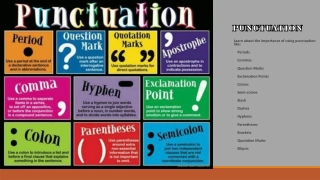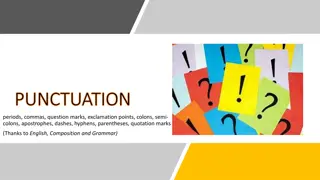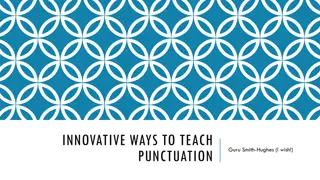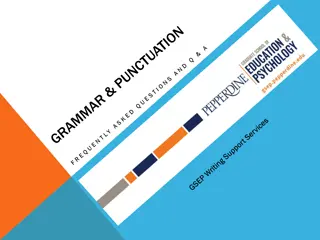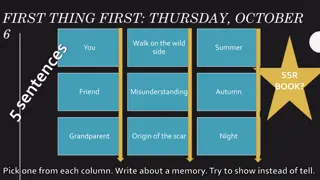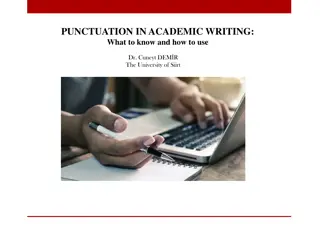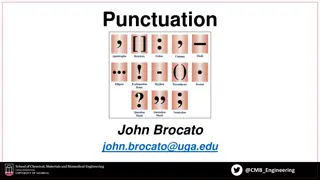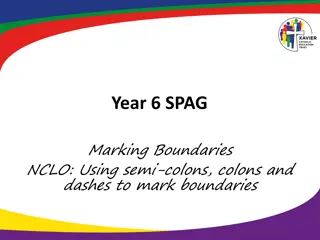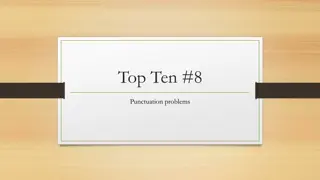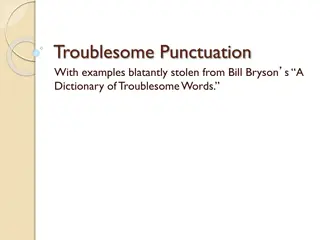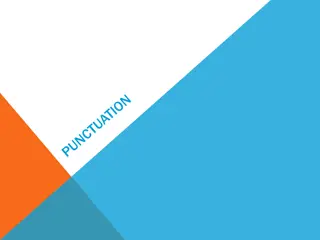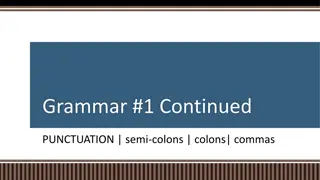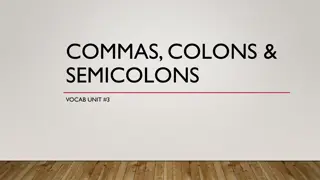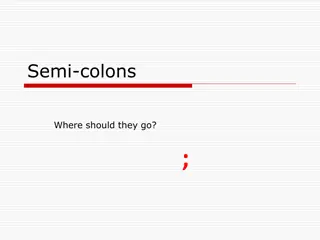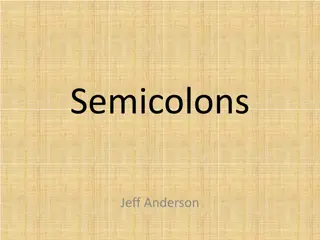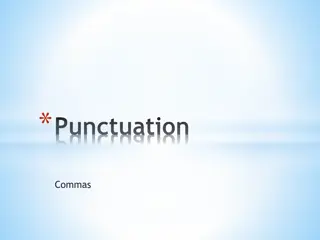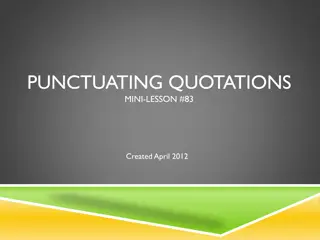Mastering Punctuation: Apostrophes, Semicolons, Colons, and Commas
Explore the nuances of punctuation with a focus on apostrophes for possessives, contractions, and plural forms; understand the usage of semicolons and colons to connect ideas and lists effectively; and master the art of using commas as separators in various contexts. Enhance your writing skills with practical examples and guidelines.
Download Presentation

Please find below an Image/Link to download the presentation.
The content on the website is provided AS IS for your information and personal use only. It may not be sold, licensed, or shared on other websites without obtaining consent from the author. Download presentation by click this link. If you encounter any issues during the download, it is possible that the publisher has removed the file from their server.
E N D
Presentation Transcript
Writing Skills Lab Readability
Learning Outcomes Recognize the standard uses of apostrophes Demonstrate the standard uses of apostrophes Critique the use of semicolons and colons. Differentiate the standard uses of semicolons and colons Demonstrate the standard uses of semicolons Demonstrate the standard uses of colons Critique the use of commas. Recognize the standard uses of commas Demonstrate the standard uses of commas Critique passages, revising for run-on sentences and fragments. Recognize run-on sentences Recognize sentence fragments Demonstrate revision for run-on sentences Demonstrate revision for sentence fragments
Singular and Plural Apostrophes With possessives, the apostrophe is used in combination with an s to indicate that a word literally or conceptually possesses what follows it. Singular words, whether or not they end in s, are made possessive by adding an apostrophe + s. For plural words, we typically indicate possession simply by adding the apostrophe without an additional s. However, for a plural that does not end in an s (e.g., bacteria), we would add an apostrophe + s. Making plural words possessive can be confusing at times because we so often add an s to a noun to make it plural. All of those s s can be a little overwhelming, but the rules are pretty simple: To make plural nouns that do not end in s possessive, add s.
Contractions A contraction is a shortened phrase. He will becomes he ll, are not becomes aren t, would have becomes would ve, and it is becomes it s. In all of these cases, the apostrophe stands in for the missing letters. You may find yourself being steered away from using contractions in your papers. While you should follow your teacher s preference, keep in mind that leaving out contractions can often make your words sound too formal and stilted. (And you shouldn t eliminate contractions in your papers just to up your word count!)
Colons and Semi-colons Semicolons serve as connectors in two ways: can connect two complete ideas (a complete idea has a subject and a verb) that are related to each other and/or equal. can be used to hold items together in a list in which items have internal commas. Use the colon when you wish to provide emphasis. Use the colon to introduce material that explains or summarizes what has preceded it. Use the colon to present a list or series, particularly when there is a lot of similar material to join or when the items in the list include commas.
Commas As Separators Perhaps the best and most instructive way to approach the comma is to remember its chief function: it is a separator. Once you know this, the next step is to determine what sorts of things generally require separation. This includes most transition words, descriptive words or phrases, adjacent items, and complete ideas (complete ideas contain both a subject and a verb). Commas are also used to separate similar items in lists. Take note of: Transition Words Descriptive Phrases Adjacent Items
Conjunctions and Lists FANBOYS Coordinating conjunctions are words that join two words or phrases of equal importance. The mnemonic FANBOYS helps us remember the seven most common: for, and, nor, but, or, yet, and so. Commas in Lists Perhaps one of the most hotly contested comma rules is the case of the serial comma. MLA style (as well as APA and Chicago) requires the use of the serial comma AP style highly recommends leaving it out. Note: Some professors and many academic journals prefer to leave out the serial comma (for the journals, it is literally cheaper to print fewer commas). Because of this, the serial comma is not recommended in AP style.
Run-on Sentences and Sentence Fragments Effective sentence structure is vital to readability. Readers become confused when sentences are incomplete, choppy, or convoluted. Writers need to pay attention to how sentence construction affects both their message and their audience. This section will help you better understand how to recognize and avoid two common sentence construction errors: fragments and run-on sentences. When you construct clearer sentences, you are able to better connect with your intended audience.
Run-on sentences Run-on sentences occur when two or more independent clauses are improperly joined. One type of run-on that you ve probably heard of is the comma splice, in which two independent clauses are joined by a comma without a coordinating conjunction (and, or, but, etc.). Fixing Run-on Sentences Before you can fix a run-on sentence, you ll need to identify the problem. When you write and revise, carefully look at each part of every sentence. Are the parts independent clauses, or are they dependent clauses or phrases? Remember, only independent clauses can stand on their own. This also means they have to stand on their own; they can t run together without correct punctuation.
Practice Question Let s take a look at a few run-on sentences and their revisions: Most of the hours I ve earned toward my associate s degree do not transfer, however, I do have at least some hours the university will accept. The opposite is true of stronger types of stainless steel they tend to be more susceptible to rust. Some people were highly educated professionals, others were from small villages in underdeveloped countries.
Quick Review Revise for readability in the later stages of your writing process. In the early stages of writing, focus on your ideas. Leave time between drafting and revising for readability. Readability errors become more evident after you have stepped away from a project for a while and return to it later. Make proofreading/editing a vital part of your writing process. Find a quiet place, free from distractions. Print a hard copy of the paper. Read the paper out loud. Read the paper backward, sentence by sentence. Enlist help.


